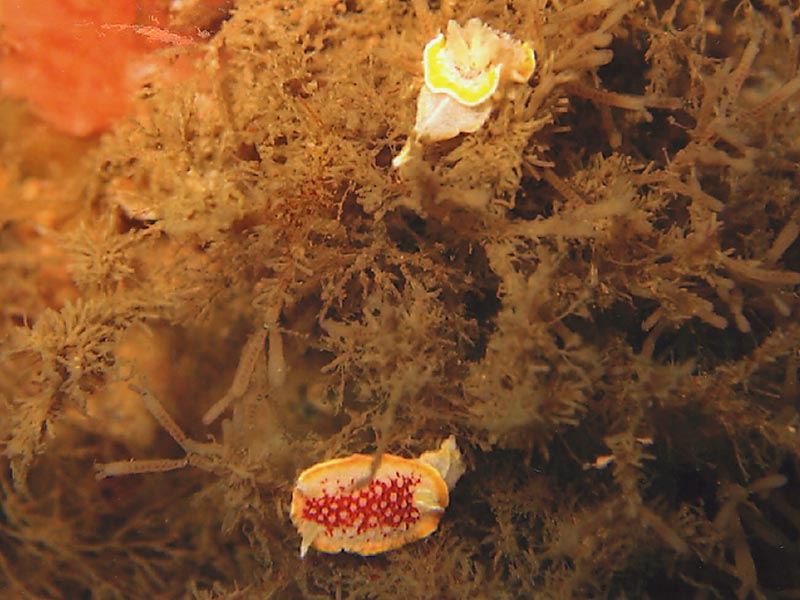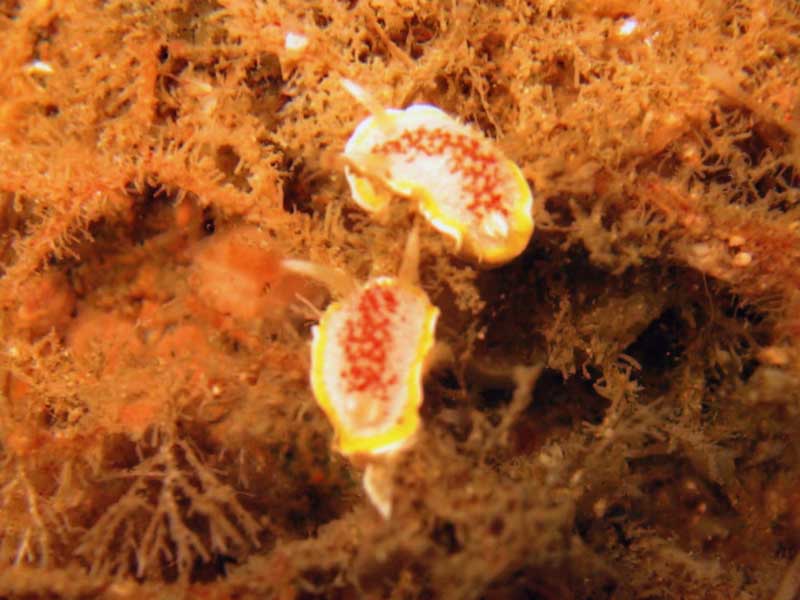Fried egg sea slug (Diaphorodoris luteocincta)
Distribution data supplied by the Ocean Biodiversity Information System (OBIS). To interrogate UK data visit the NBN Atlas.Map Help
| Researched by | Sonia Rowley | Refereed by | Admin |
| Authority | (M. Sars, 1870) | ||
| Other common names | Fried egg nudibranch | Synonyms | Onchidoris luteocincta (M. Sars, 1870) |
Summary
Description
Diaphorodoris luteocincta is an oval sea slug up to 1.1 cm in length. It is conspicuous compared to other onchidorids due to its colour; being white and having a bright to dark red blotching on its tuberculate, upper mantle and a yellow submarginal band around the mantle edge. The mantle tubercules (papilla) are white and sharply conical. The rear most part of foot (metapodium) of this species is crenulated, extends beyond the mantle and has a distinct keel. The tip of the metapodium may often be yellow in colour. The mantle bears a pair of lamellate rhinophores, and at the posterior edge; a rosette of up to seven branched gills encircling the anal papilla.
Recorded distribution in Britain and Ireland
This species is probably under recorded. However, records extend throughout the British Isles but less so from the east and south-east of England and Scotland.Global distribution
-Habitat
A common sublittoral species, found at up to 50 m depth on silty rocks and wreckage, feeding on particular species of bryozoans (see additional information).Depth range
-Identifying features
- Oval sea slug, up to 1.1 cm in length.
- White in colour with a conspicous red blotch on the mantle.
- White, conical tubercules on the mantle.
- Sub marginal yellow band around the mantle edge.
- Pair of lamellate rhinophores.
- Up to seven, branched gills.
Additional information
Diaphorodoris luteocincta feeds on heavily calcified bryzoans, primarily: Smittoidea reticulata; Cellepora pumicosa, and Crisia spp. It lays its eggs in a flattened, coiled white mass. The eggs later hatch into planktonic larvae.
A distinct variety of this species, Diaphorodoris luteocincta var. alba, lacks the red pigmentation on its upper mantle and occurs from the Mediterranean, north to the south coast of Britain. Thompson & Brown (1976) noted that the characteristic red pigmentation of Diaphorodoris luteocincta was very superficial and tended to rub off.
Listed by
- none -
Bibliography
Allen, J.A. 1962. The fauna of the Clyde Sea area. Mollusca. Millport: Scottish Marine Biological Association.
Bruce, J.R., Colman, J.S. & Jones, N.S., 1963. Marine fauna of the Isle of Man. Liverpool: Liverpool University Press.
Costello, M.J., Bouchet, P., Boxshall, G., Emblow, C. & Vanden Berghe, E., 2004. European Register of Marine Species [On-line]. http://www.marbef.org/data/erms.php,
Foster-Smith, J. (ed.), 2000. The marine fauna and flora of the Cullercoats District. Marine species records for the North East Coast of England. Sunderland: Penshaw Press, for the Dove Marine Laboratory, University of Newcastle upon Tyne.
Gibson, R., Hextall, B. & Rogers, A., 2001. Photographic guide to the sea and seashore life of Britain and north-west Europe. Oxford: Oxford University Press.
Hayward, P., Nelson-Smith, T. & Shields, C. 1996. Collins pocket guide. Sea shore of Britain and northern Europe. London: HarperCollins.
Hayward, P.J. & Ryland, J.S. (ed.) 1995b. Handbook of the marine fauna of North-West Europe. Oxford: Oxford University Press.
Howson, C.M. & Picton, B.E., 1997. The species directory of the marine fauna and flora of the British Isles and surrounding seas. Belfast: Ulster Museum. [Ulster Museum publication, no. 276.]
Naylor, P., 2003. Great British Marine Animals. Plymouth: Sound Diving Publications.
Picton, B. E. & Morrow, C.C., 1994. A Field Guide to the Nudibranchs of the British Isles. London: Immel Publishing Ltd.
Picton, B.E. & Costello, M.J., 1998. BioMar biotope viewer: a guide to marine habitats, fauna and flora of Britain and Ireland. [CD-ROM] Environmental Sciences Unit, Trinity College, Dublin.
Seaward, D.R., 1990. Distribution of marine molluscs of north west Europe. Peterborough: Nature Conservancy Council.
Thompson, C.E.L. & Amos, C.L., 2002. The impact of mobile disarticulated shells of Cerastoderma edulis on the abrasion of a cohesive substrate. Estuaries, 25, 204-214.
Thompson, T. E. & Brown, G. H., 1976. British Opisthobranch Molluscs. London: Academic Press. [Synopses of the British Fauna, no. 8.]
Thompson, T.E., 1988. Molluscs: Benthic Opisthobranchs. London: Bath Press. [Synopses of the British Fauna New Series), (ed. Doris M. Kermack & R.S.K. Barnes), no. 8 (second Edition)].
Datasets
Centre for Environmental Data and Recording, 2018. Ulster Museum Marine Surveys of Northern Ireland Coastal Waters. Occurrence dataset https://www.nmni.com/CEDaR/CEDaR-Centre-for-Environmental-Data-and-Recording.aspx accessed via NBNAtlas.org on 2018-09-25.
Conchological Society of Great Britain & Ireland, 2018. Mollusc (marine) data for Great Britain and Ireland - restricted access. Occurrence dataset: https://doi.org/10.15468/4bsawx accessed via GBIF.org on 2018-09-25.
Conchological Society of Great Britain & Ireland, 2023. Mollusc (marine) records for Great Britain and Ireland. Occurrence dataset: https://doi.org/10.15468/aurwcz accessed via GBIF.org on 2024-09-27.
Manx Biological Recording Partnership, 2022. Isle of Man historical wildlife records 1990 to 1994. Occurrence dataset:https://doi.org/10.15468/aru16v accessed via GBIF.org on 2024-09-27.
NBN (National Biodiversity Network) Atlas. Available from: https://www.nbnatlas.org.
OBIS (Ocean Biodiversity Information System), 2025. Global map of species distribution using gridded data. Available from: Ocean Biogeographic Information System. www.iobis.org. Accessed: 2025-07-26
Citation
This review can be cited as:
Last Updated: 17/04/2008




